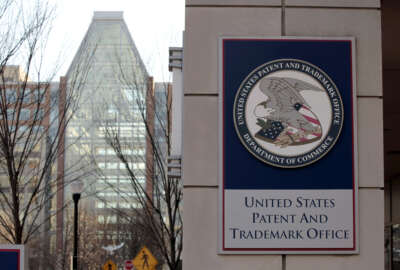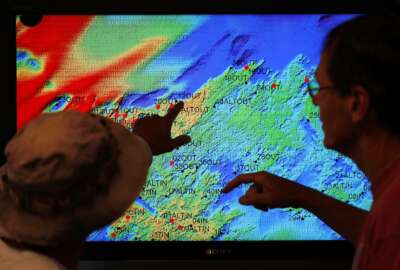

Hubbard Radio Washington DC, LLC. All rights reserved. This website is not intended for users located within the European Economic Area.
The recently-formed agency finances projects in developing countries. Now it's come up with a whole new way to measuring effectiveness.
Best listening experience is on Chrome, Firefox or Safari. Subscribe to Federal Drive’s daily audio interviews on Apple Podcasts or PodcastOne.
The U.S. International Development Finance Corporation may not be a household word, even in wonk circles. But the recently-formed agency does what its name implies. It finances projects in developing countries. Now it’s come up with a whole new way to measuring the effectiveness of its lending, called the impact quotient. With the hows and whys, the corporation’s chief development officer, Andrew Herscowitz joined Federal Drive with Tom Temin.
Interview transcript:
Tom Temin: Mr. Herscowitz, good to have you on.
Andrew Herscowitz: Great, thank you. Good morning.
Tom Temin: First of all, just review for us briefly the DFC, how it came into being, because it’s just been a couple of years now, I believe.
Andrew Herscowitz: Yeah, the DFC came into being because there was this realization that as we do development projects worldwide, and as countries become more advanced, they may not be quite at the point where they don’t need any foreign assistance. But really the private sector can play the key role in helping advance that development. So what we do is we help step in and bridge those market gaps where maybe a private bank may not be ready to give the loan, but we can give that loan for a private company to make an investment. A perfect example would be a power project, a lot of developing countries the governments might have been building those power projects themselves before we realized that there’s a lot of private sector interest in doing that. So what we’ll do is we’ll come in and we’ll give loans to those private companies that are going to build that power project. And then we get paid back, the US Treasury gets paid back at the end of the day. So really making the US taxpayer dollar go far.
Tom Temin: Alright. And now you have devised a way to make sure that the investments that the DFC does back are effective — and tell us what that is and how this came into being, what was the idea behind this new impact quotient?
Andrew Herscowitz: So the impact question, or the IQ, really it’s a way for us to measure upfront whether it’s the project that we’re designing is really going to impact people, if it’s going to impact the country and really have a sense as to why are we doing this? Is this something that’s really going to improve the environment in developing countries? So we really look at three basic factors, we look at the potential for growth, whether that’s economic growth or trade. We look at inclusion, will this project benefit women, will it benefit the disabled or indigenous people in a country? Is it inclusive? Is it designed to help people who are really living at sort of the bottom of the pyramid. And then we look at whether the project is innovative in some way. And what’s innovative in a developing country may be very different than what’s innovative in the United States. For example, while we’ve got solar and wind projects all over the United States, some countries don’t have those types of technologies. Some of them have never even had a competitively procured power project. So what we really do is we look at innovation. Innovation also can be new financial products. We have a very robust private equity market in the United States. Most countries in the world don’t have a robust private equity market. So one of the things that we do and we have a new tool is we can actually co-invest and make equity investments into projects and in funds that will help create that market, which really drives innovation.
Tom Temin: Interesting when you say innovation, one of the things you mentioned was competitive procurement, basically. And one thing I’ve learned over the years is that the federal procurement system developed in the United States is kind of a model for a lot of countries and not just undeveloped countries. Some of the European countries, former Soviet Bloc countries have had to learn how to do this. So the innovation could be bringing more accountability to those countries use of dollars that are there to benefit the public.
Andrew Herscowitz: That’s absolutely right. Because when you see things like competitive procurement, number one, you’ve got a more even playing field, you know sort of what all the factors that are going to be considered when that awards given, it removes the element of corruption — which is a struggle in a lot of developing countries, because everyone, assuming that the procurement is run properly, and you usually end up with the best price as well. And the other thing that which benefits the the end user for whatever the project may be, whether it’s a road project or a port project, and make sure that the country doesn’t end up with this sort of unsustainable sovereign debt that they owe another country that will then step in and take over that asset, as we’ve seen. So we really offer a strong alternative to countries like the path that China takes with a lot of countries in the developing world, where we will step in and say, hey you know what why don’t we have the private sector finance this, and then you’re not going to owe money to another sovereign — and if things don’t go well, you’re not going to lose that asset to another sovereign, you’re not going to sort of surrender your sovereignty. So we really offer a strong option, sort of an alternative path for developing countries.
Tom Temin: And tell us more detail about the matrix, because those are great words, inclusion and innovation and so forth, but how do you measure them? Are there specific matrixes things people fill out to be able arrive at this?
Andrew Herscowitz: Yeah, I don’t want to overly complicate it. But the idea is that we have sort of a scorecard. And we look at these items, we look at the growth, potential economic growth, we look at inclusion, we look at innovation. And then we see, is this a project that’s going to create 40 jobs, or is it a project that’s going to create 4000 jobs? And so we sort of weigh factors that way. Is this innovation something that’s truly innovative? Is this a technology that’s becoming commercial for the first time, it might get a higher score. Is it a project that’s going to have 40% or more of the employees be women, so it might get a higher score on inclusion as well? Is the management or the ownership of the company women as well? So we’ll look at the DFC we have this 2X global women’s empowerment initiative, which has been tremendously successful. We’ve helped support over $4.5 billion of investment in support of the women’s 2X initiative. If it’s a project that’s going to support 2X, that may also score extra points. But what I really like about this IQ tool is it’s not just a way of measuring sort of the development impact of the project that the potential client presents to us — it’s also an opportunity for us to sit down with that client, and help them figure out how to make their project more impactful. Is it possible for them to increase their hiring of marginalized populations or have women? Is it an opportunity for them to have improved environmental standards? Is it an opportunity for improved social safety net? Can they put policies in place that are more beneficial to the worker? Which we all realized has become increasingly more important with the global pandemic right now. So we use this tool proactively to try to make projects more developmental. And then finally DFC is in the process of developing a development strategy. So the question will be is how can we use this tool to encourage investments in the sectors that will help us advance that strategy? Whether it’s advanced water and sanitation projects or health projects or financial inclusion projects. How can we encourage both the deal teams here to seek out those types of projects and also do more outreach to clients who work in those sectors?
Tom Temin: And on the impact principles that you have published, you’ve got a number of signatories, organizations frankly I haven’t heard of themv — they look like a combination of nonprofits and profit companies.
Andrew Herscowitz: What we’ve done is we widely consulted with like you said many different use development jargon stakeholders. So whether those are people working in the development community, or clients of ours, private companies, or members of Congress and staff who work on the hill in think tanks. So we really look hard about getting a lot of input about what makes things work because really what we do as DFC as any development finance institution, our role is to really play that bridge between entities like USAID which focuses largely on giving grants, and that type of assistance, and banks, which, look at things entirely on a commercial basis. So we see a lot of opportunities, particularly in developing countries, where there are opportunities for financing for equity investments for guarantees. And we can step in and bridge that gap, which is critically important right now, as we face this global economic crisis. And we see a lot of banks who are nervous and we see a lot of businesses that are struggling. So this really is the moment for DFC and other development finance institutions to shine.
Tom Temin: Andrew Herscowitz is chief Development Officer at the US International Development Finance Corporation. Thanks so much for joining me.
Andrew Herscowitz: Thank you.
Copyright © 2024 Federal News Network. All rights reserved. This website is not intended for users located within the European Economic Area.
Tom Temin is host of the Federal Drive and has been providing insight on federal technology and management issues for more than 30 years.
Follow @tteminWFED



